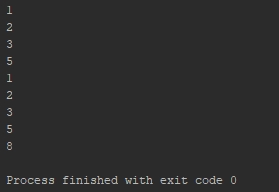-
Book Overview & Buying

-
Table Of Contents

Advanced JavaScript
By :

Advanced JavaScript
By:
Overview of this book
 Free Chapter
Free Chapter
 Sign In
Start Free Trial
Sign In
Start Free Trial

 Free Chapter
Free Chapter
You have been tasked with building a simple app that generates numbers in the Fibonacci sequence upon request. The app generates the next number in the sequence for each request and resets the sequence it is given an input. Use a generator to generate the Fibonacci sequence. If a value is passed into the generator, reset the sequence. You may start the Fibonacci sequence at n=1 for simplicity.
To highlight how the generators can be used to build iterative datasets, follow these steps:
Look up the Fibonacci sequence and understand how the next value is calculated.
Create a generator for the Fibonacci sequence.
Inside the generator, set up the default values for current and next (0, 1) using variables n2 and n1.
Create an infinite while loop.
Inside the while loop, use the yield keyword to provide the current value in the sequence and save the return value of the yield statement into a variable called input.
If input contains a value, reset the variables n2 and n1 to their starting values.
Inside the while loop, calculate the new next value from current + next and save it into the variable next.
Otherwise update n2 to contain the value from n1 (the next value) and set n1 to the next value that we calculated at the top of the while loop.
Code:
index.jsfunction* fibonacci () {
let n2 = 0;x
let n1 = 1;
while ( true ) {
let input = yield n2;
if ( input ) {
n1 = 1;
n2 = 0;
} else {
let next = n1 + n2;
[ n1, n2 ] = [ next, n1 ];
}
}
}
let gen = fibonacci();Snippet 1.87: Implementing a generator
Outcome:

Figure 1.19: Fibonacci sequence with a generator
You have successfully demonstrated how generators can be used to build an iterative data set based on the Fibonacci sequence.

Change the font size
Change margin width
Change background colour